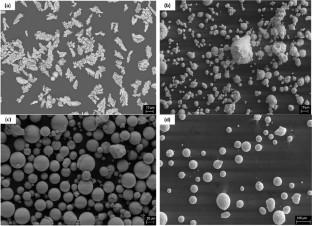Journal of Thermal Spray Technology ( IF 3.1 ) Pub Date : 2024-03-26 , DOI: 10.1007/s11666-024-01762-y Niloofar Eftekhari , Hamid Jahed

|
In this study, the role of feedstock powder in influencing the characteristics of cold spray deposition is explored. Four distinct types of Cu feedstock powders, derived through electrolysis and employing varied gas atomization methods, are applied to a Cu substrate via low-pressure cold spray coating. We investigated the impact of feedstock powder on the resultant coatings' microstructure and mechanical properties. A comprehensive statistical model is developed, considering the cold spray parameters, weight change, coating thickness, and discerning their significance and interactions. Optimal conditions for carrier gas temperature and pressure are identified at approximately 400 °C and 1.99 MPa, respectively, consistent across all Cu powders. Velocity analysis reveals particle velocities ranging from 373 to 564 m/s under these optimal conditions. Coatings deposited using satellite-free gas-atomized powder, characterized by enhanced sphericity, exhibit superior characteristics, including minimal porosity (0.66 ± 0.35%), high flattening ratio (3.57 ± 1.51), elevated microhardness (107 ± 3 HV) and high bonding strength (20.7 ± 2.3 MPa). In contrast, coatings deposited with gas-atomized powder featuring microsatellite particles and electrolytic powder with irregular shapes display distinct properties. The observed trends are attributed to lower oxygen content and reduced oxide levels near the surface of the more spherical, satellite-free powder. This powder also demonstrates heightened plastic deformation during deposition. The increased peening effect of satellite-free gas-atomized powder during cold spray results in elevated dynamic recrystallization near the substrate surface, leading to smaller grains at the interface. Microstructural evolution analysis, utilizing electron backscatter diffraction, further elucidates the heterogeneous deformation and grain refinement occurring in Cu splats during cold spray coating.
中文翻译:

低压冷喷涂涂层微观结构和机械属性的比较分析:不同铜原料粉末的影响
在本研究中,探讨了原料粉末对冷喷涂沉积特性的影响。通过电解并采用不同的气体雾化方法获得四种不同类型的铜原料粉末,通过低压冷喷涂将其涂覆到铜基材上。我们研究了原料粉末对所得涂层的微观结构和机械性能的影响。开发了一个综合统计模型,考虑了冷喷涂参数、重量变化、涂层厚度,并辨别它们的重要性和相互作用。载气温度和压力的最佳条件分别确定为约 400 °C 和 1.99 MPa,所有铜粉都一致。速度分析显示,在这些最佳条件下,粒子速度范围为 373 至 564 m/s。使用无卫星气雾化粉末沉积的涂层具有增强的球形度,表现出优异的特性,包括最小的孔隙率 (0.66 ± 0.35%)、高扁平比 (3.57 ± 1.51)、较高的显微硬度 (107 ± 3 HV) 和高结合力强度(20.7±2.3MPa)。相比之下,用具有微卫星颗粒的气雾化粉末和不规则形状的电解粉末沉积的涂层显示出不同的特性。观察到的趋势归因于更接近球形、无卫星的粉末表面附近氧含量的降低和氧化物水平的降低。这种粉末在沉积过程中还表现出增强的塑性变形。冷喷涂过程中无卫星气体雾化粉末的喷丸效果增强,导致基材表面附近的动态再结晶增强,从而导致界面处的晶粒变小。利用电子背散射衍射的微观结构演化分析,进一步阐明了冷喷涂过程中铜片中发生的不均匀变形和晶粒细化。



























 京公网安备 11010802027423号
京公网安备 11010802027423号